World Roundup
November/December 2018
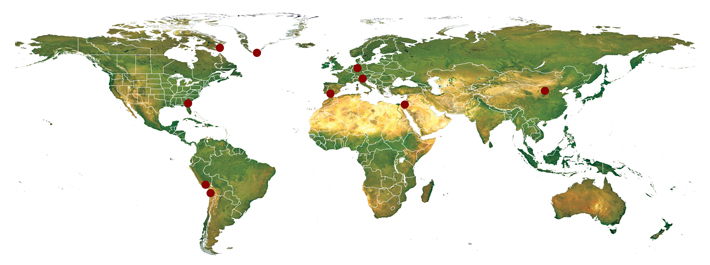

-
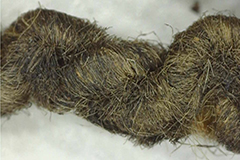 CANADA: It was once believed that around A.D. 1000, Norse explorers taught Paleo-Inuit communities in the Canadian Arctic how to weave animal hair and sinews into yarn. However, dating these textiles has been problematic because they are often contaminated by whale and seal oil, rendering attempts at radiocarbon dating unreliable. A new process, however, has successfully removed these contaminants and accurately dated a textile sample from Baffin Island, proving that spun yarn and weaving technology predated European contact by at least a millennium.
CANADA: It was once believed that around A.D. 1000, Norse explorers taught Paleo-Inuit communities in the Canadian Arctic how to weave animal hair and sinews into yarn. However, dating these textiles has been problematic because they are often contaminated by whale and seal oil, rendering attempts at radiocarbon dating unreliable. A new process, however, has successfully removed these contaminants and accurately dated a textile sample from Baffin Island, proving that spun yarn and weaving technology predated European contact by at least a millennium. -
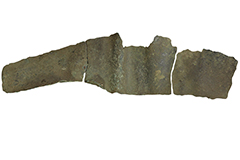 GEORGIA: At least 7 cremation burials and a copper band from St. Catherine’s Island show that Native Americans living there 3,500 years ago exchanged goods and cultural ideas through surprisingly long-distance trade networks. Analysis of the copper artifact’s chemical signature determined that it originated almost 1,000 miles away in the Great Lakes region. This new evidence is a clear indication that the use of copper and the practice of cremation were introduced to coastal Georgia 1,000 years earlier than previously thought.
GEORGIA: At least 7 cremation burials and a copper band from St. Catherine’s Island show that Native Americans living there 3,500 years ago exchanged goods and cultural ideas through surprisingly long-distance trade networks. Analysis of the copper artifact’s chemical signature determined that it originated almost 1,000 miles away in the Great Lakes region. This new evidence is a clear indication that the use of copper and the practice of cremation were introduced to coastal Georgia 1,000 years earlier than previously thought. -
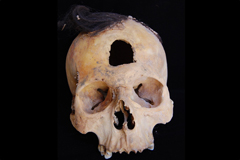 PERU: The 1,500-year-old remains of at least 60 individuals from the La Ramada culture were discovered in a series of deep pits in the Vitor Valley of southern Peru. Six trophy heads were also found in the graves. Trophy heads were sometimes removed from enemies killed in battle, but these examples may have actually belonged to friendly combatants. Since it was burdensome to transport the bodies of fallen comrades home, only the heads may have been brought back for burial within the community.
PERU: The 1,500-year-old remains of at least 60 individuals from the La Ramada culture were discovered in a series of deep pits in the Vitor Valley of southern Peru. Six trophy heads were also found in the graves. Trophy heads were sometimes removed from enemies killed in battle, but these examples may have actually belonged to friendly combatants. Since it was burdensome to transport the bodies of fallen comrades home, only the heads may have been brought back for burial within the community. -
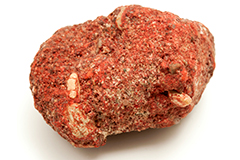 CHILE: A unique 500-year-old burial of 2 ritually sacrificed Inca females was found at Cerro Esmeralda in the 1970s. The pair were dressed in fine clothing and buried with lavish grave goods. New chemical analysis of the red pigment from their clothes detected cinnabar, a mineral not native to northern Chile. While the cinnabar itself was a prestige item, imported from hundreds of miles away, it can also be highly toxic when inhaled, and may have been used to deter would-be grave robbers.
CHILE: A unique 500-year-old burial of 2 ritually sacrificed Inca females was found at Cerro Esmeralda in the 1970s. The pair were dressed in fine clothing and buried with lavish grave goods. New chemical analysis of the red pigment from their clothes detected cinnabar, a mineral not native to northern Chile. While the cinnabar itself was a prestige item, imported from hundreds of miles away, it can also be highly toxic when inhaled, and may have been used to deter would-be grave robbers. -
 GREENLAND: Norse settlers once thrived in Greenland before vanishing in the 15th century. A new theory suggests that a decline in the medieval walrus-ivory market may have sent them packing. DNA analysis of walrus bones from sites around western Europe shows that during the 13th and 14th centuries, most of the ivory entering the continent belonged to walrus populations found around Greenland, and may have been exclusively supplied by Norse Greenlanders. When the demand for walrus ivory diminished, these settlers may have been forced to abandon the island.
GREENLAND: Norse settlers once thrived in Greenland before vanishing in the 15th century. A new theory suggests that a decline in the medieval walrus-ivory market may have sent them packing. DNA analysis of walrus bones from sites around western Europe shows that during the 13th and 14th centuries, most of the ivory entering the continent belonged to walrus populations found around Greenland, and may have been exclusively supplied by Norse Greenlanders. When the demand for walrus ivory diminished, these settlers may have been forced to abandon the island. -
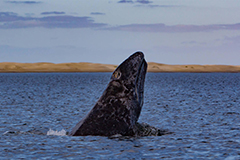 SPAIN: Roman whalers? Perhaps. A new study using advanced technology was able to identify the bones of both the North Atlantic right whale and the gray whale from a handful of Roman sites around the Strait of Gibraltar. Southern Iberia was once home to a thriving Roman fish-processing industry. Although these whale species no longer frequent these waters, researchers argue that around 1,500 to 2,000 years ago, they would have been prevalent in the western Mediterranean and were likely hunted by Roman fishermen.
SPAIN: Roman whalers? Perhaps. A new study using advanced technology was able to identify the bones of both the North Atlantic right whale and the gray whale from a handful of Roman sites around the Strait of Gibraltar. Southern Iberia was once home to a thriving Roman fish-processing industry. Although these whale species no longer frequent these waters, researchers argue that around 1,500 to 2,000 years ago, they would have been prevalent in the western Mediterranean and were likely hunted by Roman fishermen. -
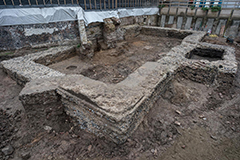 GERMANY: In 2017, when archaeologists initially unearthed the foundations of a large 2nd-century A.D. Roman building buried near Cologne’s center, they believed it was a public assembly hall. However, further excavations revealed that the interior walls were lined with a series of peculiar niches, uncharacteristic of such a structure. Experts now believe that these recesses were once used to store scrolls, as many as 20,000, and that the ruins are those of Germany’s earliest known public library.
GERMANY: In 2017, when archaeologists initially unearthed the foundations of a large 2nd-century A.D. Roman building buried near Cologne’s center, they believed it was a public assembly hall. However, further excavations revealed that the interior walls were lined with a series of peculiar niches, uncharacteristic of such a structure. Experts now believe that these recesses were once used to store scrolls, as many as 20,000, and that the ruins are those of Germany’s earliest known public library. -
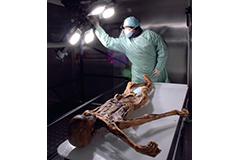 ITALY: Although the ice mummy known as Ötzi was discovered in the Alps more than a quarter century ago, his remains continue to provide information about daily life more than 5 millennia ago. Scientists recently examined the corpse’s surprisingly well-preserved stomach contents to determine what he ate just prior to his death. They learned that his last meal was chock-full of essential minerals required for good health, and consisted of fat and meat from wild ibex and red deer, as well as whole grain cereals.
ITALY: Although the ice mummy known as Ötzi was discovered in the Alps more than a quarter century ago, his remains continue to provide information about daily life more than 5 millennia ago. Scientists recently examined the corpse’s surprisingly well-preserved stomach contents to determine what he ate just prior to his death. They learned that his last meal was chock-full of essential minerals required for good health, and consisted of fat and meat from wild ibex and red deer, as well as whole grain cereals. -
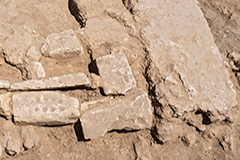 ISRAEL: Pottery workers at a Roman ceramics factory enjoyed some workplace perks that rival even the recreational areas of today’s Silicon Valley tech campuses. The complex was founded in the 3rd century A.D. near Gedera and specialized in producing wine storage jars. A large bath complex, containing 20 pools of hot and cold water, was located adjacent to the manufacturing floor, along with a room that provided various gaming boards etched into its stone benches.
ISRAEL: Pottery workers at a Roman ceramics factory enjoyed some workplace perks that rival even the recreational areas of today’s Silicon Valley tech campuses. The complex was founded in the 3rd century A.D. near Gedera and specialized in producing wine storage jars. A large bath complex, containing 20 pools of hot and cold water, was located adjacent to the manufacturing floor, along with a room that provided various gaming boards etched into its stone benches. -
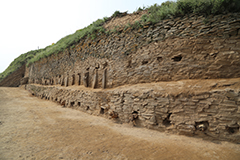 CHINA: The ruins of a massive walled city from the site of Shimao in northern China are revising ancient Chinese history. Archaeologists originally thought the site was part of the Great Wall, since they had not expected to find an enormous prehistoric complex in such a peripheral region. Shimao, however, apparently flourished around 2000 B.C., when it was the largest known settlement in China. At its center was a 230-foot-tall stepped pyramid, which contained 11 platforms and was used as a residential palace for local rulers.
CHINA: The ruins of a massive walled city from the site of Shimao in northern China are revising ancient Chinese history. Archaeologists originally thought the site was part of the Great Wall, since they had not expected to find an enormous prehistoric complex in such a peripheral region. Shimao, however, apparently flourished around 2000 B.C., when it was the largest known settlement in China. At its center was a 230-foot-tall stepped pyramid, which contained 11 platforms and was used as a residential palace for local rulers.
Advertisement
IN THIS ISSUE
From the Trenches
The American Canine Family Tree
Off the Grid
Mars Explored
Aztec Fishing
Iron Age Teenagers
Hand of God
Beauty Endures
Let Them Eat Soup
Another Form of Slavery
Eat More Spore
Well, Well
Nomadic Necropolis
Conan's Storm Cellar
World Roundup
Aztec rain temple, Ötzi’s last meal, Roman whalers, and Germany’s oldest public library
Artifact
A draft of comfort
Advertisement

Recent Issues
-
 May/June 2024
May/June 2024
-
 March/April 2024
March/April 2024
-
 January/February 2024
January/February 2024
-
 November/December 2023
November/December 2023
-
 September/October 2023
September/October 2023
-
 July/August 2023
July/August 2023
-
 May/June 2023
May/June 2023
-
 March/April 2023
March/April 2023
-
 January/February 2023
January/February 2023
-
 November/December 2022
November/December 2022
-
 September/October 2022
September/October 2022
-
 July/August 2022
July/August 2022
-
 May/June 2022
May/June 2022
-
 March/April 2022
March/April 2022
-
 January/February 2022
January/February 2022
-
 November/December 2021
November/December 2021
-
 September/October 2021
September/October 2021
-
 July/August 2021
July/August 2021
-
 May/June 2021
May/June 2021
-
 March/April 2021
March/April 2021
-
 January/February 2021
January/February 2021
-
 November/December 2020
November/December 2020
-
 September/October 2020
September/October 2020
-
 July/August 2020
July/August 2020
-
 May/June 2020
May/June 2020
-
 March/April 2020
March/April 2020
-
 January/February 2020
January/February 2020
-
 November/December 2019
November/December 2019
-
 September/October 2019
September/October 2019
-
 July/August 2019
July/August 2019
-
 May/June 2019
May/June 2019
-
 March/April 2019
March/April 2019
-
 January/February 2019
January/February 2019
-
 November/December 2018
November/December 2018
-
 September/October 2018
September/October 2018
-
 July/August 2018
July/August 2018
-
 May/June 2018
May/June 2018
-
 March/April 2018
March/April 2018
-
 January/February 2018
January/February 2018
-
 November/December 2017
November/December 2017
-
 September/October 2017
September/October 2017
-
 July/August 2017
July/August 2017
-
 May/June 2017
May/June 2017
-
 March/April 2017
March/April 2017
-
 January/February 2017
January/February 2017
-
 November/December 2016
November/December 2016
-
 September/October 2016
September/October 2016
-
 July/August 2016
July/August 2016
-
 May/June 2016
May/June 2016
-
 March/April 2016
March/April 2016
-
 January/February 2016
January/February 2016
-
 November/December 2015
November/December 2015
-
 September/October 2015
September/October 2015
-
 July/August 2015
July/August 2015
-
 May/June 2015
May/June 2015
-
 March/April 2015
March/April 2015
-
 January/February 2015
January/February 2015
-
 November/December 2014
November/December 2014
-
 September/October 2014
September/October 2014
-
 July/August 2014
July/August 2014
-
 May/June 2014
May/June 2014
-
 March/April 2014
March/April 2014
-
 January/February 2014
January/February 2014
-
 November/December 2013
November/December 2013
-
 September/October 2013
September/October 2013
-
 July/August 2013
July/August 2013
-
 May/June 2013
May/June 2013
-
 March/April 2013
March/April 2013
-
 January/February 2013
January/February 2013
-
 November/December 2012
November/December 2012
-
 Sep/Oct 2012
Sep/Oct 2012
-
 September/October 2012
September/October 2012
-
 July/August 2012
July/August 2012
-
 May/June 2012
May/June 2012
-
 March/April 2012
March/April 2012
-
 January/February 2012
January/February 2012
-
 November/December 2011
November/December 2011
-
 September/October 2011
September/October 2011
-
 July/August 2011
July/August 2011
-
 May/June 2011
May/June 2011
-
 March/April 2011
March/April 2011
-
 January/February 2011
January/February 2011
Advertisement






